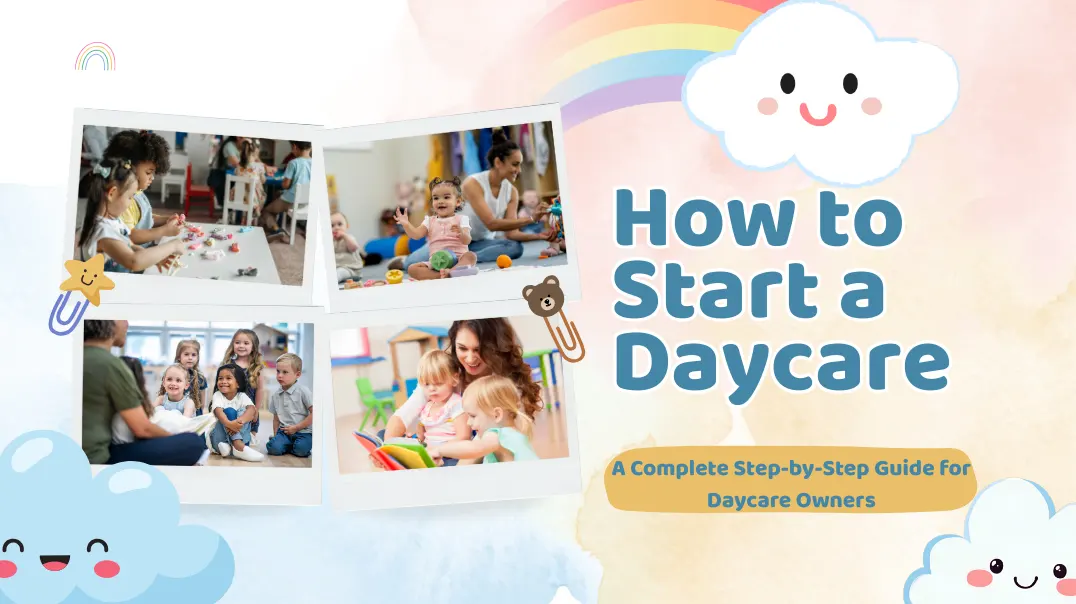Are you struggling with the first steps to opening a daycare? Do you worry about balancing quality and cost, especially when importing furniture? Regulations abound, budgets are tight, building parent trust is challenging, and curriculum and safety standards are fraught with scrutiny. Any flaw in any step can ruin all your efforts. Many entrepreneurs searching for “How to Start a Daycare” only find scattered advice, lacking a clear path from compliance to enrollment. This information asymmetry and cognitive burden can make a career filled with love and a sense of purpose seem like a lost cause.
Without a clear roadmap, it’s easy to make costly mistakes. Many people rush into starting a daycare without understanding licensing rules, safety standards, or how to properly market their services. One misstep can delay your launch, put children at risk, or worse. The fuzzier your grasp of the key steps in how to start a daycare, the more likely you are to hit landmines across licensing, insurance, budgeting, brand positioning, curriculum structure, and enrollment conversion, turning a venture that should grow steadily into a mess.
Keep reading—I’ll walk you through every detail, with insights from my experience serving daycare founders across North America, Europe, and Australia.
What is a Daycare Center?
A daycare center is a regulated facility designed to provide care, supervision, and basic education for young children during the day, often while their parents or guardians are at work. Typically catering to infants, toddlers, and preschool-aged children, daycare centers are a critical part of early childhood development and socialization.
Daycare centers can vary in size, structure, and philosophy. Some operate from private homes (often referred to as home daycares), while others function as large commercial centers with multiple staff members and formal curricula. Regardless of the format, the central focus remains the same: to offer a safe, nurturing, and engaging environment for children during their formative years.

Why Start a Daycare?
The decision to start a daycare business is often rooted in both passion and practicality. For many, the appeal lies in the opportunity to positively shape young minds while running a profitable, community-centered business.
1. High Demand and Market Growth
The childcare industry continues to grow, driven by workforce participation and awareness of early childhood development. According to reports, the U.S. childcare market is projected to surpass $83 billion by 2027.
2. Personal Fulfillment
Operating a daycare is deeply rewarding. It allows you to contribute positively to a child’s formative years, shape their early learning experience, and build a nurturing community.
3. Financial Potential
A well-run daycare can be a profitable venture. With efficient operations, proper staffing, and community trust, the potential for long-term earnings is significant.
4. Flexible Business Models
You can operate a home-based daycare with lower overhead or scale into a commercial facility. This flexibility allows you to align the business with your resources and vision.
5. Community Impact
Daycare centers support working families, enhance educational readiness, and strengthen local economies by enabling parents to participate in the workforce confidently.
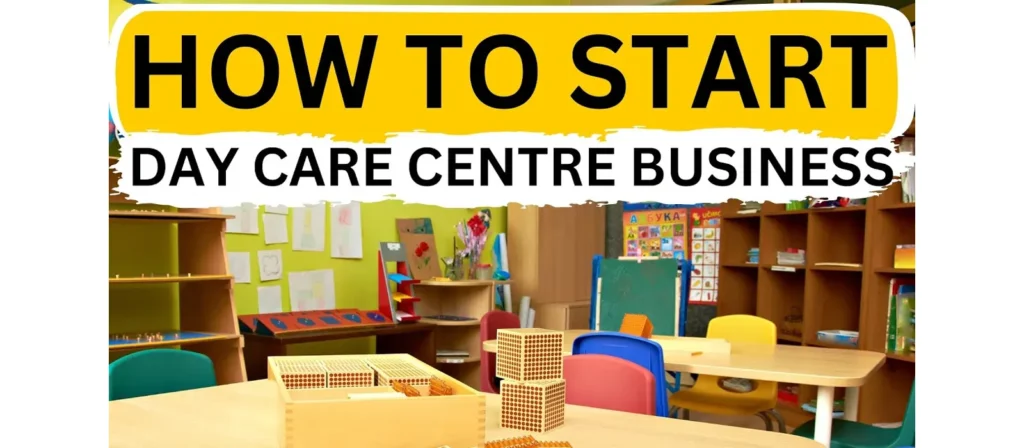
How to Start a Daycare Business? Things You Need to Know
Starting a daycare requires detailed planning, compliance with state regulations, and a strong commitment to child welfare. Below is a practical roadmap to guide your journey.
1. Determine the Type of Daycare Business to Operate
One of the most pivotal choices you’ll make when deciding how to start a daycare is choosing between a daycare center and a home daycare. Each model comes with its own set of regulations, space limitations, staffing expectations, and administrative demands. Your decision should be based on your budget, long-term goals, location, and local licensing allowances.
Let’s break down what’s required for both types of daycare businesses so you can choose the right fit for your needs and the community you aim to serve.
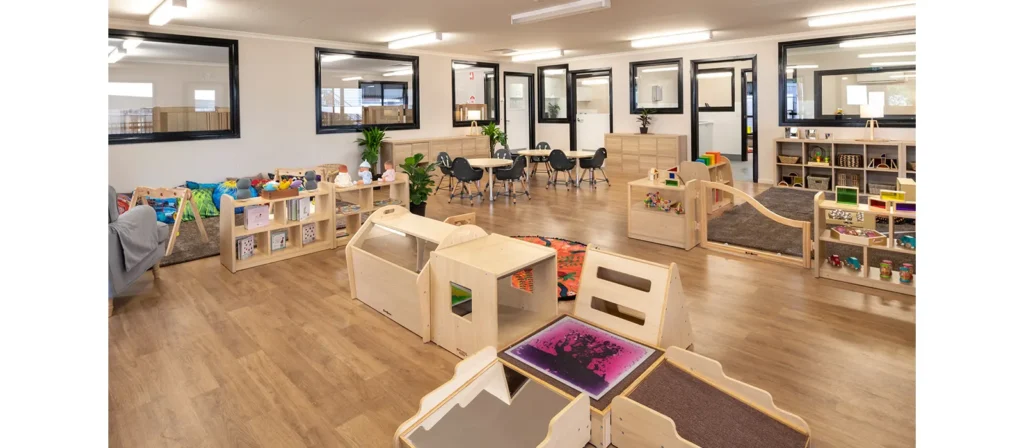
Daycare Center Service Requirements
Operating a daycare center, typically a commercial facility separate from your home, means adhering to a more comprehensive set of state-mandated requirements. These regulations exist to ensure high-quality care and adequate supervision for larger groups of children.
1. Center Capacity Requirements
Every state limits the number of children a daycare center can accommodate based on square footage, facility layout, and available staff. A typical requirement is around 35 square feet per child indoors and 75 square feet per child outdoors. This includes room for nap areas, play zones, learning stations, and administrative space. Failure to meet these capacity requirements can lead to license denial or revocation.
2. Staffing Ratios
Staffing ratios are critical to both legal compliance and child safety. These ratios ensure each child receives proper attention. For instance:
- Infants (0–12 months): 1 staff per 3–4 infants
- Toddlers (1–2 years): 1 staff per 5–6 toddlers
- Preschool (3–5 years): 1 staff per 8–10 children
- School-aged children: 1 staff per 12–15 children
Centers must document and report these ratios daily to avoid penalties and ensure licensing compliance.
3. Director Requirements
Every center must have a designated Daycare Director, responsible for overseeing curriculum implementation, staff training, compliance, and parent communication. Directors often require:
- A bachelor’s degree in early childhood education or a related field
- Childcare experience (typically 2–5 years)
- State-specific certifications or credentialing
- Completion of a licensed director training program
The director sets the tone for the center’s culture, professionalism, and instructional quality.
4. Teacher Requirements
Lead teachers and assistant teachers in a center setting must meet educational and experience requirements as defined by the state. These may include:
- High school diploma or GED (minimum)
- Completion of early childhood education (ECE) coursework
- Child Development Associate (CDA) credential
- State-required in-service training hours
Many states also require ongoing professional development to maintain teaching qualifications.
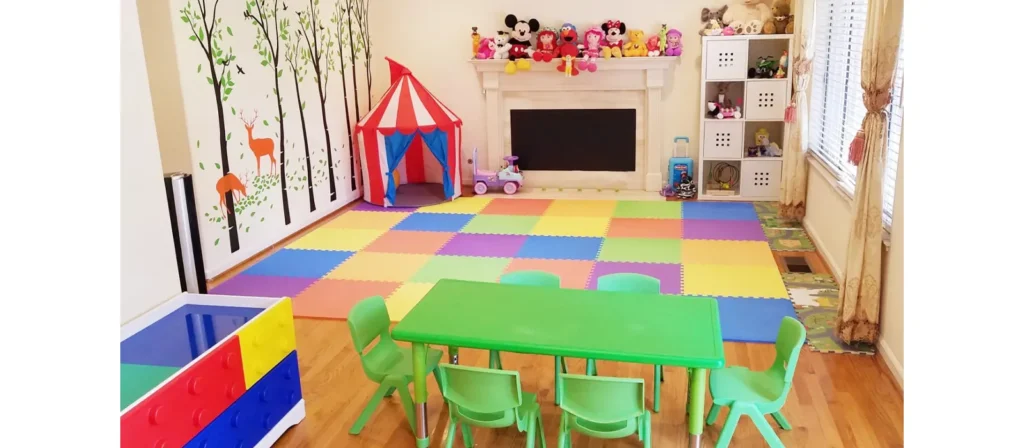
Home Daycare Service Requirements
Home daycares are operated from a private residence and are often a great starting point for entrepreneurs with limited capital. While regulations are slightly more lenient than center-based care, strict standards still apply.
1. Home Space Capacity
Just like centers, home daycares must meet space-per-child minimums. However, the limits are usually smaller, capping at around 6–12 children, including the caregiver’s own children under a certain age (typically under 5 years old). Specific rules often require a dedicated space for childcare, separate from the main living area.
2. Staffing Ratios
Just like daycare centers, home daycares must also follow staff-to-child ratios. For example:
- If you’re the only caregiver, you may be limited to caring for 6 children with no more than 2 under the age of two.
- If you employ an assistant, your capacity and ratio flexibility increases.
Always check your state’s specific ratio requirements, especially when infants and toddlers are involved.
3. Teacher Requirements
As the primary caregiver and educator in a home daycare, you must meet minimum qualifications. These often include:
- Being over 18 years of age
- Having a high school diploma or GED
- Completing orientation or training in early childhood development
- Holding current CPR and First Aid certifications
Some states require home daycare providers to take pre-service training and obtain continuing education credits annually.
2. Understand Daycare Licensing Requirements
Licensing ensures that your daycare operates legally, protects children, and builds parental trust. While requirements differ across states and countries, most jurisdictions regulate facilities under strict health, safety, and education codes. Compliance is non-negotiable, and failing to secure proper licensing can result in fines, closure, or even liability in case of accidents.
Licensing typically covers:
- Zoning and Building Approval – Confirmation that your property is authorized for childcare use. For example, some municipalities require a Certificate of Occupancy or zoning permit before children may be admitted.
- Health and Sanitation Standards – Approval from the local health department regarding food service, sanitation, diapering areas, and hand-washing facilities. A health inspection certificate is usually required.
- Fire and Safety Compliance – Inspection and certification from the fire marshal, confirming fire exits, alarm systems, extinguishers, smoke detectors, and posted evacuation routes meet code.
- Capacity and Ratio Compliance – Certification that your daycare complies with square footage per child, age-specific group size, and staffing ratio requirements.
- Staff Background Checks – Criminal background checks and child abuse registry clearances for all staff, substitutes, and volunteers. In the U.S., this often includes FBI fingerprinting.
- Staff Training Certifications – Proof of CPR and First Aid training, Safe Sleep training (for infant care), Mandated Reporter training, and often a minimum number of annual professional development hours.
- Food Program Approval (if serving meals) – Certification from the Child and Adult Care Food Program (CACFP) or equivalent, which ensures compliance with nutritional standards and may qualify your center for meal subsidies.
- Childcare License or Registration Certificate – The core operating license issued by your state or region’s Department of Human Services, Department of Education, or similar authority. This license must be displayed prominently within your facility.
3. Choose a Business Structure
Choosing the right business structure is one of the most important legal and financial decisions when starting a daycare. The structure you select will determine how you pay taxes, how much personal liability you carry, and how investors or partners can participate. Below are four common structures for daycare businesses, along with their advantages and disadvantages.
- Sole Proprietorship: A sole proprietorship is the simplest and most affordable structure to establish. It means you alone own and operate the daycare. You report business income and expenses on your personal tax return, and there are typically fewer paperwork and legal formalities.
- Partnership: If you’re starting a daycare with one or more people, a partnership allows you to share responsibilities, costs, and profits. Partnerships can be general partnerships (where all partners share equal responsibility and liability) or limited partnerships (where some partners invest but have limited liability).
- Limited Liability Company (LLC): An LLC is one of the most popular choices for daycare businesses in the U.S. It combines the flexibility of a sole proprietorship or partnership with the liability protection of a corporation. Owners (called “members”) are not personally responsible for most business debts or legal claims.
- Corporation (C-Corp or S-Corp): Incorporating your daycare creates a separate legal entity. A C-Corp pays taxes as a company, while an S-Corp allows profits and losses to pass through to shareholders’ personal tax returns (if eligible). Corporations are typically chosen by larger daycare centers that want to expand, franchise, or attract investors.
4. Researching Your Target Market
Understanding your target audience is essential for setting pricing, services, and even your daily schedule. Begin by analyzing:
- Local demographics: Age distribution, family income levels, number of working parents
- Competitor offerings: What do other daycare centers provide, and at what cost?
- Community needs: Is there demand for after-school care, bilingual instruction, or infant care?
Conduct surveys, host informational meetings, or speak directly with parents to gather insights. This data will shape your business plan and marketing strategy.

Steps to Starting a Daycare Business
Starting a daycare business from the ground up is a rewarding endeavor, but it requires strategic planning and precise execution. To build a trustworthy and profitable daycare center, each step should be approached with both professionalism and passion. Below are the core phases and essential elements involved in launching your daycare successfully.
1. Developing a Daycare Business Plan
The daycare business plan is your blueprint for turning vision into action. It outlines how your center will function, who it will serve, and how it will grow. A strong plan is essential for securing funding, attracting partners, and guiding your operations during the early stages.
Key Components of a Daycare Business Plan:
- Executive Summary: A concise overview of your daycare’s mission, vision, and value proposition.
- Company Description: Details on the daycare’s legal structure, ownership, and location.
- Market Analysis: Research on the local demand for childcare, competitor assessment, target audience demographics, and market gaps.
- Organizational Structure: Information on your staffing model, leadership roles, and reporting hierarchy.
- Services Offered: Age groups served, operating hours, meal plans, special programs (bilingual, STEM-based, nature-focused, etc.).
- Marketing and Sales Strategy: Outreach plans, promotional activities, digital strategy, and enrollment process.
- Operational Plan: Day-to-day logistics including scheduling, classroom layouts, drop-off/pick-up routines, and record keeping.
- Financial Projections: Budget forecasts, startup costs, break-even analysis, revenue expectations, and cash flow statements.
Developing this document helps you clarify your approach, calculate risk, and demonstrate professionalism to stakeholders.
2. Seeking Grants and Funding
Starting a daycare can be capital-intensive, but many financial support options exist. Research local, state, and federal grants aimed at small businesses and early childhood programs. These may include:
- Government Grants: Many local and federal agencies offer grants to support early childhood education initiatives, particularly in underserved areas.
- Nonprofit and Foundation Support: Organizations focused on family welfare and education may provide seed funding or resources.
- Childcare Stabilization Funds: In response to increased demand, some governments offer stabilization grants to help new daycares with rent, payroll, and PPE supplies.
- Small Business Loans: Banks and credit unions often provide small business financing, especially if you have a solid business plan and collateral.
- Crowdfunding: Platforms like Kickstarter or GoFundMe can be used to rally support from your community.
Always review eligibility criteria carefully and be prepared to submit detailed business and financial documentation.
3. Researching Possible Tax Credits
Depending on your jurisdiction, you may qualify for employer-provided childcare credits if you partner with businesses, credits for hiring from certain populations, or incentives for facility improvements like energy-efficient lighting and HVAC. Families using your program may qualify for their own credits or dependent care accounts, and your marketing should explain how to use those benefits. Consult a tax professional to structure your entity and payroll to take advantage of eligible credits while staying compliant with subsidy billing rules, if you accept them.

4. Registering Your Business
No matter where you are in the world, if you want to run a daycare legally, registration is mandatory. Registering your daycare means the government recognizes it as a legitimate business entity—and that you’re protected as an operator.
When figuring out how to start a daycare, registration is the formal moment when your idea becomes a business.
Steps typically include:
- Selecting a legal structure (sole proprietorship, LLC, corporation, etc.)
- Registering your business name with local authorities
- Applying for a tax identification number or business license
- Setting up a business bank account
- Registering for payroll or VAT (depending on your region)
- Register for payroll accounts if you plan to hire employees.
Remember, registration also helps you gain access to grants, contracts, and business credit. It’s not just a legal step—it’s a smart one.
5. Obtain Required Licenses and Permits
No step in the process of how to start a daycare is more critical—or more time-consuming—than licensing. Without proper documentation, your daycare cannot operate legally. And even if you open an unlicensed facility, it exposes you to fines, closures, and potential legal action.
In some areas, this process can take two to six months, so it should be initiated early. Even while you’re still preparing your classrooms and sourcing your furniture. Many of our international clients apply for their license as soon as they sign a lease, knowing it will run in parallel with construction and delivery timelines.
6. Find a Location for Your Daycare Center
The location you choose for your daycare significantly affects your enrollment, reputation, and operational efficiency. Whether you’re starting from home or leasing a commercial space, the right location must meet licensing standards, provide convenience for families, and support child safety.
For Home Daycares:
Evaluate your available space against licensing requirements. You may need to dedicate specific rooms to the daycare, install child-proofing devices, and fence off outdoor areas. Your home must also pass health, safety, and fire inspections.
For Center-Based Daycares:
- Доступность: Is it convenient for working parents and near schools, hospitals, or public transport?
- Space Requirements: Most states require a minimum of 35 square feet of indoor space per child and 75 square feet of outdoor play area.
- Zoning Compliance: Verify that your location is approved for childcare use.
- Parking and Drop-off Areas: Safe, accessible drop-off zones reduce liability and improve parent satisfaction.
- Expansion Potential: As your enrollment grows, will the space grow with you?
Before signing a lease or purchasing property, verify zoning compliance and potential renovation needs. Any modifications must be pre-approved and inspected before opening.
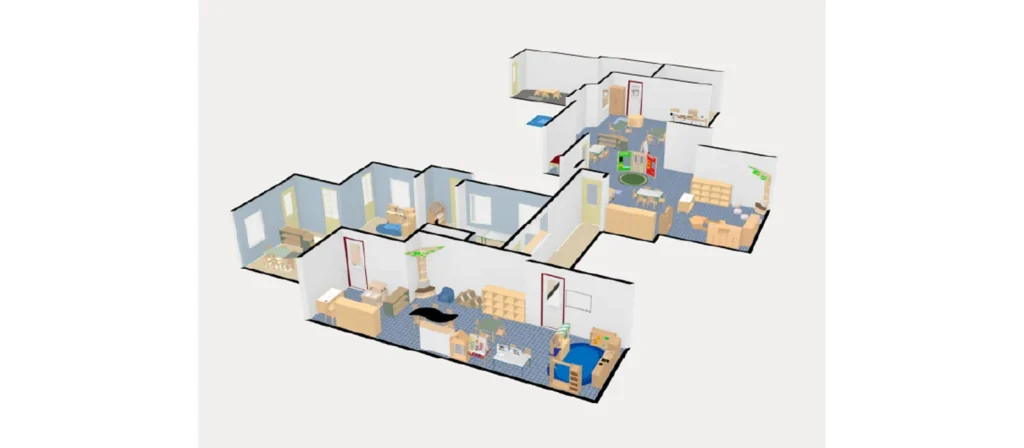
7. Consider Classroom Design
The classroom environment shapes learning, behavior, and emotional well-being. Designing age-appropriate, stimulating spaces enhances children’s development and sets your daycare apart.
Classroom Layout:
Divide classrooms into multiple zones:
- Reading corners
- Creative art stations
- Sensory play areas
- Quiet/resting zones
- Active play space
Use low shelves and furniture to define areas without obstructing supervision. Include open floor space for movement and group activities.
Furniture and Materials:
Choose durable, age-appropriate, and easy-to-clean furniture. Cribs, changing tables, toddler-sized tables and chairs, and high chairs should be certified for childcare use.
Décor and Environment:
Aim for a calming atmosphere with natural lighting, soft colors, and interactive wall decorations. Avoid overstimulation through loud colors or cluttered visuals.
Safety Features:
Install outlet covers, secure cords, anchor shelves, and use gates or barriers as needed. Ensure sightlines are clear for staff supervision.
Напишите нам, если у вас есть вопросы или запросите расценки. Наши специалисты ответят вам в течение 48 часов и помогут выбрать нужный вам продукт.
8. Establish Business Operations
Before opening day, build your back-office engine. Choose a childcare management system for enrollment, waitlists, digital forms, attendance, tuition billing, and family communication. Enable autopay to improve cash flow. Draft a monthly admin calendar covering invoicing, payroll processing, subsidy claims, staff schedule publication, safety drills, refrigerator temperature logs, and curriculum planning meetings.
Design a tour and enrollment process that feels human and organized. Record every inquiry, schedule tours within a week, follow up within 24 hours, and send a clear next-steps checklist: application, fee, immunization records, orientation meeting, and start date. Implement a ticketing approach for service requests so families and staff know their concerns are seen and resolved.
9. Hire Staff as Needed
As your daycare business grows, hiring qualified and reliable staff becomes essential to maintaining a safe and nurturing environment for children. Whether you need one assistant or an entire team, your staff will directly impact the quality of care and your center’s reputation.
What positions do you need?
- Lead teachers (with certifications in early childhood education)
- Assistant teachers or aides
- A center director (if you’re not managing daily operations yourself)
- Kitchen staff (if meals are provided)
- Janitorial support or part-time cleaners
- Administrative personnel for parent communication and recordkeeping
Recruitment Tips:
- Define Roles Clearly: Determine how many lead teachers, assistants, floaters, or administrative staff you need based on capacity and age groups.
- Verify Qualifications: Ensure candidates meet state-mandated education and experience requirements for childcare providers.
- Conduct Background Checks: Complete criminal background checks, child abuse clearances, and fingerprinting as part of the hiring process.
- Provide Orientation and Training: Offer onboarding sessions covering safety protocols, curriculum goals, and daily procedures.
- Encourage Professional Development: Support ongoing learning with workshops, certifications, and annual in-service training.
10. Develop Safety Protocols
Safety must be embedded into every aspect of your daycare operations. Begin with a comprehensive safety manual that covers procedures for health, environment, supervision, and emergencies.
Daily safety includes childproofing classrooms: secured furniture, outlet covers, locked cabinets, and gated stairs. Develop protocols for diapering, sanitizing toys, handwashing, and mealtime to minimize illness spread. Post allergy charts with children’s photos and ensure all staff know how to administer EpiPens or other emergency medication.
Emergency readiness is non-negotiable. Create written procedures for fire drills, lockdowns, severe weather, and evacuation to an alternate site. Conduct monthly practice drills and keep documentation for licensing inspectors. Review safe sleep policies: infants must sleep on their backs, in individual cribs with fitted sheets and no loose items, under continuous visual supervision with documented checks every 10–15 minutes.
Supervision standards should be crystal clear. Require teachers to perform frequent headcounts, maintain sight-and-sound supervision at all times, and never leave a child alone—even briefly. Establish a “stop-the-line” culture where any staff member can pause activities to address a hazard without hesitation.
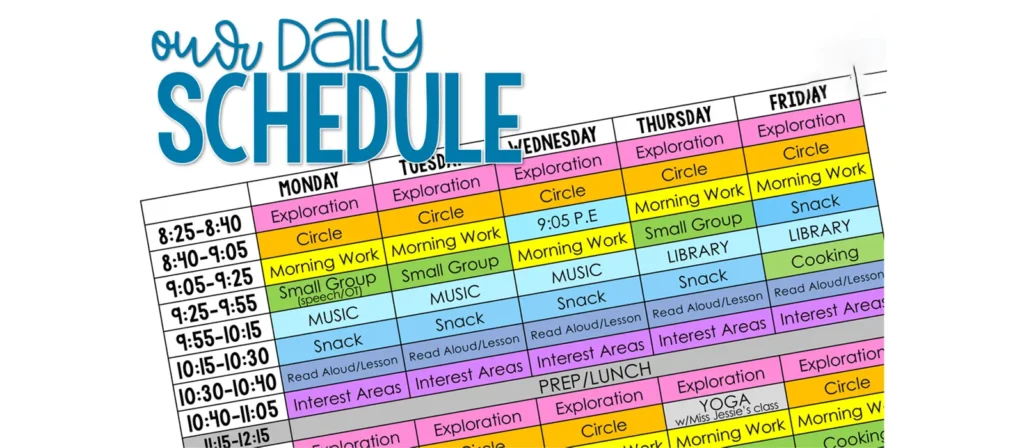
11. Design Daycare Curriculum and Daily Activities
A daycare center isn’t just a place where children are looked after; it’s a learning environment that supports their multifaceted growth. Your curriculum should reflect a coherent educational philosophy. Whether it’s play-based, Montessori, Reggio Emilia, or a blended approach, provide developmentally appropriate experiences for children of every age.
Daily schedules should balance structured learning, free play, outdoor time, meals, naps, and transitions. Routines build security, but allow flexibility for children’s interests. For example, if a group of preschoolers becomes fascinated with insects they find outside, extend the day’s activities into an impromptu science exploration.
Document learning by displaying children’s work with captions of their quotes or teachers’ observations. Share these regularly with families through newsletters or a parent app. Parents want assurance that their children are not only safe but also learning, growing, and preparing for school success.
12. Establish Policies and Procedures
Clear policies are the backbone of a professional daycare. They prevent confusion, ensure consistency, and protect both families and staff.
Your parent handbook should cover:
- Enrollment requirements and process.
- Tuition rates, payment schedules, and late fees.
- Pickup and drop-off procedures.
- Health and illness exclusion policies.
- Discipline and guidance philosophy.
- Medication and allergy management.
- Holiday closures and inclement weather procedures.
- Field trip permissions and media/photo release.
Your employee handbook should outline:
- Code of conduct and dress standards.
- Confidentiality and data protection policies.
- Supervision and child interaction expectations.
- Mandated reporter obligations.
- Sick leave, vacation policies, and scheduling rules.
- Training requirements and performance evaluation processes.
Policies should be reviewed annually and updated to reflect changes in regulations or operational experience. Train staff on policies thoroughly during orientation and reinforce them in monthly meetings. Families should sign acknowledgment forms, ensuring they understand the expectations before their child begins care.
13. Purchase Insurance
Insurance is a cornerstone of risk management in the childcare industry. Without it, even a single incident could put your daycare out of business.
Key policies to secure include:
- General Liability Insurance – Covers accidents and injuries occurring at your facility.
- Professional Liability (Errors and Omissions) – Protects against claims related to negligence or improper care.
- Property Insurance – Covers damage to your building, furniture, and equipment.
- Workers’ Compensation – Required if you employ staff, covering workplace injuries.
- Abuse and Molestation Coverage – A critical policy for childcare businesses, covering legal defense and settlements in sensitive cases.
- Commercial Auto Insurance – Necessary if you provide transportation services.
- Business Interruption Insurance – Helps replace lost income if you must close temporarily due to a disaster.
Review policies annually with a broker who specializes in childcare businesses. Ensure coverage limits align with state requirements and the scale of your program. Parents often ask about insurance; having robust policies in place enhances trust and credibility.

14. Market Your Daycare
Even the best daycare cannot succeed without enrollment. A strong marketing strategy ensures parents know about your program and feel confident choosing it.
Start early by building a professional website with program descriptions, staff bios, tuition information, testimonials, and high-quality photos of your facility. Optimize for local SEO so your daycare appears when parents search “daycare near me” or “preschool in [city].”
Use social media platforms—Facebook, Instagram, and even TikTok to share updates, classroom projects, parenting tips, and staff introductions. Encourage satisfied parents to leave positive reviews on Google and social media platforms; word-of-mouth referrals remain the most powerful marketing tool.
Locally, distribute flyers in pediatric clinics, libraries, community centers, and workplaces. Partner with local employers who may subsidize childcare or promote your program to employees. Host open house events where families can tour your facility, meet teachers, and ask questions.

How to Run Your New Daycare?
Once your daycare is open, your role shifts from founder to operator. Running a daycare effectively requires consistency, communication, attention to detail, and a child-centered mindset. Beyond just providing supervision, your goal is to foster a nurturing, educational, and safe environment every single day.
Here’s how to operate a successful daycare center after launch:
Improve Daily Childcare Services
Your daily operations should be well-organized, child-focused, and predictable enough to create security, while flexible enough to accommodate real-life situations. A typical day should include:
- Structured routines: Children thrive on predictability. Establish regular times for meals, naps, learning activities, and outdoor play.
- Balanced learning: Incorporate a mix of individual and group activities across all developmental areas—language, social, motor, and cognitive skills.
- Nutritious meals and snacks: Whether you provide food or allow families to bring it, ensure meals are balanced and follow health department regulations.
- Behavior guidance strategies: Use positive reinforcement, redirection, and age-appropriate discipline strategies to promote cooperation.
Keep the environment emotionally safe and physically inviting. Staff should model respectful behavior, manage transitions smoothly, and stay engaged with the children throughout the day.
Develop Your Team’s Skills
Your staff is the lifeblood of your daycare. Even the best curriculum will fail if teachers are undertrained, undervalued, or unsupported. Professional development should be an ongoing process, not a one-time orientation.
Develop a training schedule that includes mandatory certifications in CPR, first aid, safe sleep practices, mandatory reporter training, and enrichment training in child development, behavior management, and inclusive education. Encourage employees to pursue additional certifications, such as Child Development Associate (CDA), and consider offering tuition reimbursement as a retention strategy.
Observation and feedback should happen weekly, not annually. Directors should step into classrooms regularly, noting both strengths and areas for growth. Feedback should be short, specific, and actionable.
Maintain Safety and Cleanliness
A daycare’s reputation can collapse overnight if parents perceive unsafe or unsanitary conditions. Safety and cleanliness are not one-time achievements but daily disciplines.
- Daily cleaning routines: Disinfect toys, surfaces, and bathrooms regularly. Implement cleaning logs to ensure accountability.
- Safe facility standards: Routinely inspect furniture, outdoor equipment, and play areas for damage or hazards.
- Secure entrances and exits: Use keypad systems, sign-in sheets, and ID verification to control access.
- Illness prevention: Follow strict illness exclusion policies and educate parents about symptoms to watch for.
Manage Daycare Finances
Once your daycare is running, financial management becomes your survival skill. A full classroom one month and several withdrawals the next can destabilize your cash flow if you are not prepared.
Track key performance indicators (KPIs):
- Labor costs as a percentage of revenue (ideally 50–60%).
- Occupancy rates by classroom.
- Average tuition per child.
- Days cash on hand.
Review budgets monthly. Anticipate cyclical costs like annual licensing renewals, insurance premiums, or seasonal supply purchases. Negotiate contracts with food, cleaning, and supply vendors to keep expenses predictable.
As you grow, set aside a reserve fund equal to at least two months of operating expenses. Financial stability allows you to focus on quality rather than scrambling to cover payroll or rent.
Keep the Curriculum Fresh
Children grow fast—and their needs change fast. You can’t afford to run the same lesson plans for months on end. A stagnant curriculum reflects poorly on your brand and leads to disengagement among both students and teachers.
How to keep things fresh:
- Plan lessons around seasons, holidays, and current events
- Introduce new materials monthly (books, art supplies, toys)
- Rotate learning centers weekly
- Invite guest educators—artists, firefighters, musicians
- Collect feedback from parents on what their kids are enjoying at home
Maintain Communication with Parents
Running a successful daycare requires excellent communication with parents. When families feel informed and involved, they’re far more likely to stay enrolled and recommend you to others.
Часто задаваемые вопросы
- How much does it cost to start a daycare?
Startup costs vary depending on your location, size, and model. A home daycare may cost between $2,000 and $10,000, while a center-based facility can require $30,000 to $100,000 or more. Major expenses include licensing, rent or renovations, furniture, staff salaries, and marketing. - Do I need a degree to start a daycare?
Not always. Licensing requirements vary by state or country. While you may not need a formal degree, you’ll likely need certifications in CPR, first aid, and early childhood education. Some jurisdictions require directors or lead teachers to have a CDA or similar credential. - Can I start a daycare in my home?
Yes, home-based daycares are a popular and cost-effective option. However, you must meet local licensing requirements, pass safety inspections, and follow space and staffing regulations. Your home must be adequately child-proofed and zoned for childcare use. - How long does it take to open a daycare?
The timeline ranges from 3 to 12 months, depending on the licensing process, renovations, funding, and business planning. It’s crucial not to rush—each step must meet regulatory standards to ensure safe and legal operation. - How long does it take to get licensed?
Licensing time varies by state. It can take from a few weeks to several months. The process involves applications, inspections, and background checks.
Заключение:
Starting and running a daycare is both a business and a calling. It takes vision, discipline, and heart to create a space where children feel safe, supported, and inspired to grow.
From crafting a solid business plan and securing funding to creating a safe, vibrant learning space, each step you take lays the foundation for lasting impact.
Success in daycare requires both heart and strategy. It means committing to continuous improvement, investing in your staff, and staying in tune with the needs of your community. Whether you’re opening a cozy home daycare or a bustling center, you are taking on the vital responsibility of shaping young lives.

